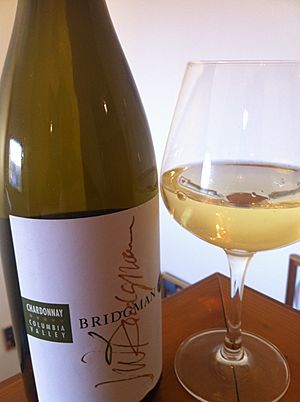Columbia Valley AVA facts for kids
| Wine region | |
 |
|
| Official name | Columbia Valley AVA |
|---|---|
| Type | American Viticultural Area |
| Year established | 1984 |
| Country | United States |
| Part of | Oregon, Washington |
| Sub-regions | Ancient Lakes AVA, Horse Heaven Hills AVA, Lake Chelan AVA, Naches Heights AVA, Rattlesnake Hills AVA, Red Mountain AVA, The Rocks AVA, Snipes Mountain AVA Wahluke Slope AVA, Walla Walla Valley AVA, Yakima Valley AVA |
| Growing season | 180-200 days |
| Climate region | Continental/Mediterranean |
| Precipitation (annual average) | 6 inches (15 cm) to 8 inches (20 cm) |
| Total area | 11,308,636 acres (17,670 sq mi) |
| Size of planted vineyards | 59,234 acres (23,971 ha) |
| Varietals produced | Barbera, Black Muscat, Cabernet Franc, Cabernet Sauvignon, Carmenere, Chardonnay, Chenin blanc, Counoise, Gamay Beaujolais, Gamay noir, Gewurztraminer, Grenache, Lemberger, Malbec, Marsanne, Merlot, Morio Muskat, Mourvedre, Muscadelle, Muscat Canelli, Nebbiolo, Orange Muscat, Petit Verdot, Petite Sirah, Pinot blanc, Pinot gris, Pinot Meunier, Pinot noir, Riesling, Roussanne, Royalty, Sangiovese, Sauvignon blanc, Semillon, Siegerrebe, Syrah, Viognier, Zinfandel |
| Wine produced | Varietal, dessert wine, Meritage, and sparkling wine |
| Comments | Map depicts only Washington state of the Columbia Valley AVA which also extends into northern Oregon. |
The Columbia Valley AVA is a very large and important area for growing grapes in the United States. AVA stands for American Viticultural Area. This means it's a special region recognized for its unique grape-growing conditions. It covers a big part of central and southern Washington State, and a small piece of northern Oregon.
This area includes the Columbia River and its smaller rivers. In 1984, the government officially recognized it as an AVA. This was important for helping Washington State's vineyards become famous. The Columbia Valley AVA is the biggest wine region in Washington. It has over 11 million acres, with more than 50,000 acres planted with grapevines. This means almost all of Washington's vineyards are found here!
Many different kinds of grapes grow here. Some popular ones are Cabernet Sauvignon, Merlot, Chardonnay, Riesling, Syrah, Pinot gris, and Sauvignon blanc. Other grapes like Concord grapes are also grown. The climate here is special. It helps the grapes make wines that taste very fruity, like those from California. But they also have the balance and structure of wines from Europe.
Where is the Columbia Valley AVA?

The Columbia Valley AVA is mostly in Washington state. A small part is in Oregon. The Cascade Range mountains are on its western side. To the east, you'll find the Palouse region. The Okanogan National Forest and Canada are to the north.
This area includes valleys made by the Columbia River. Other rivers like the Walla Walla River, Snake River, and Yakima River also flow through it. The Columbia Valley is located between the 46th and 47th parallel north. This is the same latitude as famous French wine regions like Bordeaux and Burgundy.
Because it's so far north, the area gets more daylight in summer. It has two more hours of sunlight than California wine regions. This extra light helps the grapes grow well. The soil here is made of volcanic ash and sand. This type of soil drains water well and doesn't have too many nutrients. This is good for grapevines because it makes them focus their energy on growing tasty grapes.
Inside the large Columbia Valley AVA, there are nine smaller, special grape-growing areas. These are called Ancient Lakes AVA, Yakima Valley AVA, Red Mountain AVA, Walla Walla Valley AVA, Horse Heaven Hills AVA, Rattlesnake Hills AVA, Lake Chelan AVA, Snipes Mountain AVA, and Wahluke Slope AVA. Each of these smaller areas has its own unique features for growing grapes.
What Makes the Climate Special?
The Columbia Valley AVA is huge, so it has many different small climates. But all parts share some things in common. They have cold winters and long, dry summers. The air is not very humid.
The days are warm, but the nights are cool. This helps the grapes keep a good balance of acid and sugar. This balance gives Washington wines their special taste. Grapes ripen during the last four to six weeks of summer. They stay on the vines longer than in California. This extra time helps the grapes develop rich flavors and aromas. Harvesting grapes when it's cooler also helps keep their quality high.
One big challenge for grape growers here is very cold winters. Temperatures can drop quickly, sometimes below 0°F (-18°C). Many vineyards use wind turbines. These machines help keep the air moving around the grapes. This stops them from freezing. Most years, the grapevines go into a deep sleep during winter. This helps them stay healthy and grow well when spring comes.
How Do They Water the Grapes?
The Cascade Mountains create a "rain shadow" effect. This means the Columbia Valley gets very little rain, sometimes less than 6 inches (15 cm) a year. So, to grow grapes, farmers need to water them.
Special irrigation systems have been built. These systems bring water from the Columbia, Snake, Yakima, and Walla Walla rivers. Growers can control exactly when and how much water the grapevines get. This careful watering helps them grow the best quality grapes. It also helps control how much fruit each vine produces.




